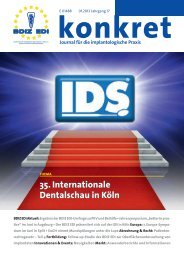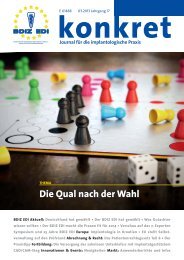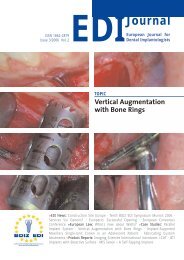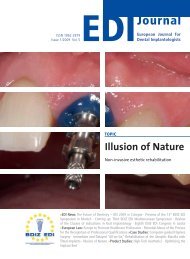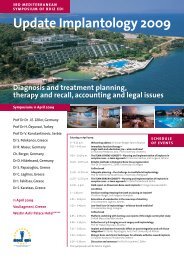EDI - European Association of Dental Implantologists
EDI - European Association of Dental Implantologists
EDI - European Association of Dental Implantologists
Create successful ePaper yourself
Turn your PDF publications into a flip-book with our unique Google optimized e-Paper software.
38<br />
<strong>EDI</strong><br />
<strong>EDI</strong> News<br />
Implementation and design<br />
Some <strong>of</strong> these limitations were disadvantageous,<br />
most importantly those concerning the planned randomized<br />
study. However, it was still our goal to<br />
secure public sponsoring, as the university budget<br />
did not cover our need for human and technical<br />
resources. A number <strong>of</strong> German institutions took<br />
part in developing the “Tübingen implant”: the Institute<br />
for Medical Biometrics in Tübingen; the Institute<br />
<strong>of</strong> Pathology (and animal farm) at the University <strong>of</strong><br />
Heidelberg; the Fraunh<strong>of</strong>er Institute for Mechanics <strong>of</strong><br />
Materials in Freiburg, the Max Planck Institute for<br />
Metal Research in Stuttgart; and the development<br />
department <strong>of</strong> Friedrichsfeld GmbH in Mannheim.<br />
In the 1960s, extensive investigations <strong>of</strong> periodontal<br />
histology had been performed in Tübingen. Other studies<br />
had focused on oral wound healing and specific<br />
hematological reactions for bone regeneration. The<br />
results <strong>of</strong> these studies went into the implant body<br />
design. For a comprehensive overview <strong>of</strong> the research<br />
program, the reader is referred to ZM 74 (19/20), 1981 and<br />
Quint Int 15: 2267, 1984. Numerous references are <strong>of</strong>fered<br />
in these sources. Following basic anatomical studies,<br />
plans for implant placement were originally confined to<br />
specific jaw segments (sites 15 to 25, 34 to 44).<br />
The transmucosal implant element was polished<br />
to a high gloss. In addition to reducing plaque accumulation,<br />
this surface treatment was intended to<br />
ensure the organismic principle <strong>of</strong> ectodermal<br />
integrity in the transmucosal area. In natural teeth,<br />
this integrity is ensured by hemidesmosomal attachment<br />
<strong>of</strong> the inner junctional epithelium to the<br />
cementoenamel junction. However, lack <strong>of</strong> such<br />
attachment can remain without consequences for<br />
decades in the presence <strong>of</strong> recessions because the<br />
epithelium will also become attached to the very<br />
smooth mesodermal cementum.<br />
Based on previous haematological findings about<br />
blood-clot attachment, the enossal surface was blasted<br />
with aluminium oxide particles. The resultant<br />
microtexture was characterized by peaks and valleys<br />
<strong>of</strong> 1 to 5 μm, causing the coagulation and attachment<br />
<strong>of</strong> blood to aluminium oxide surfaces in a matter <strong>of</strong><br />
seconds. Connection was established down to the<br />
molecular level, meeting the quintessential requirement<br />
for speedy organization <strong>of</strong> endosteal tissue!<br />
Both principles were implemented for the first<br />
time and have since been adopted by almost all<br />
implant manufacturers, most notably in recent systems.<br />
Incidentally, the effect <strong>of</strong> surface roughness on<br />
final strength really continues to be an open question.<br />
This conclusion was drawn after we measured<br />
the osseointegration <strong>of</strong> different implant systems in<br />
vivo using the Periotest system.<br />
The implant body was designed<br />
as a conical step cylinder. This<br />
shape was based on the consideration<br />
that implants cannot – as<br />
natural teeth can – introduce<br />
loads into the cranial skeleton by<br />
a push-pull transformation within<br />
the periodontium. Most <strong>of</strong><br />
today’s implants are designed<br />
with threads. However, the ethical<br />
requirements defined by the state<br />
ministry precluded the use <strong>of</strong><br />
threads, since they would have<br />
involved bone loss in the event <strong>of</strong><br />
treatment failure. Rather than<br />
threads, the implant body was<br />
designed to feature lacunae, initially filling with<br />
blood and later with bone. The gross surface (not<br />
including the microstructure) was generally around<br />
55 to 65 percent larger than the surface <strong>of</strong> a natural<br />
root.<br />
The results obtained in animal experiments were<br />
so excellent that, as soon as 1978, the Tübingen/Heidelberg<br />
group won the DGZMK award for<br />
best performance <strong>of</strong> the year. Optimal results were<br />
even obtained in clinical studies, despite entering<br />
uncharted territory. A number <strong>of</strong> rules (frequently<br />
disregarded or highly controversial ever since) were<br />
considered essential. Care was taken to preserve the<br />
marginal gingiva with its fibrous structure and inner<br />
junctional epithelium, requiring careful handling <strong>of</strong> a<br />
periotome to separate the periodontal ligament. Any<br />
reduction <strong>of</strong> the facial alveolar wall and bony interdental<br />
septa was strictly avoided. Instead, the<br />
implant bed was palatally relocated (in relation to<br />
the alveolar axis) and cranially deepened. Finally, an<br />
undisturbed healing period <strong>of</strong> three months was<br />
observed prior to loading the implants.<br />
Excellent statistical results were also obtained. As a<br />
result, another eleven universities agreed to take part<br />
in the clinical studies. These collaborations started in<br />
1977 and were followed up by annual symposia in<br />
Tübingen.<br />
After the phase <strong>of</strong> sponsoring by the Baden-Württemberg<br />
State Ministry <strong>of</strong> Economic Affairs had<br />
ended and Frialit-1 had been introduced in the<br />
market, the German Research Society (Deutsche For -<br />
schungs gesellschaft, DFG) created an opportunity<br />
for the study groups to continue their work. The<br />
research objectives were considerably broadened.<br />
Led by the author, a dedicated research institute was<br />
launched and maintained from 1984 to 1996. Being<br />
the largest effort <strong>of</strong> its kind worldwide, this initiative<br />
The Tübingen<br />
implant.




